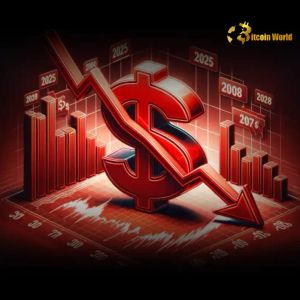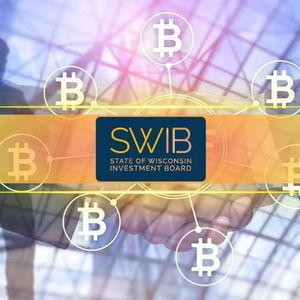BitcoinWorld US Dollar Slump: Stagflation Jitters Signal Economic Danger Ahead For many involved in the cryptocurrency space, understanding macro-economic trends is crucial. The recent weakening of the US Dollar isn’t just a headline for Forex traders; it has potential ripple effects across global markets, including digital assets. The dollar’s significant slump, coupled with growing concerns about stagflation, paints a complex picture for the future Economic Outlook . Understanding the Recent Dollar Slump The United States Dollar has long held its position as the world’s primary reserve currency, a symbol of stability and economic power. However, recent months have seen a noticeable and, for some, alarming Dollar Slump against various major currencies. This isn’t a minor fluctuation; it’s a sustained downtrend that has analysts pointing to several contributing factors. What exactly is causing this decline? Several elements are at play: Trade Policies and Tariffs: While not the sole cause, the lingering effects of protectionist trade policies and the imposition of tariffs have created uncertainty and strained international relationships. This can negatively impact the perceived stability of the dollar and US economy. Fiscal and Monetary Policy: The Federal Reserve’s stance on interest rates and the government’s spending patterns play a significant role. Policies perceived as inflationary or leading to ballooning national debt can erode confidence in the currency. Global Economic Recovery (or lack thereof): As other economies show signs of recovery, or as investors seek opportunities elsewhere, capital flows can shift away from dollar-denominated assets. Increased Global Debt: The sheer volume of global debt, much of it dollar-denominated, creates a complex dynamic where a weaker dollar can make servicing this debt easier for some, but also signals potential underlying economic fragility. This slump is more than just numbers on a screen; it impacts everything from the cost of imported goods to the profitability of multinational corporations. Why Are We Talking About Stagflation Now? The term Stagflation strikes fear into the hearts of economists and policymakers. It describes a situation where the economy experiences stagnant growth (or recession) simultaneously with high inflation and high unemployment. Historically, inflation and unemployment tend to move in opposite directions (the Phillips Curve), and inflation typically occurs during periods of strong economic growth. Stagflation breaks these norms, presenting a difficult challenge for central banks, as traditional tools to combat inflation (raising rates) can worsen unemployment and slow growth, while tools to stimulate growth (lowering rates) can fuel inflation. The current environment is raising red flags for several reasons: Supply Chain Disruptions: Global supply chain issues, exacerbated by geopolitical events and the pandemic aftermath, are driving up the cost of goods and services (inflation). Energy Prices: Volatile and often rising energy prices are a significant inflationary pressure, impacting transportation, manufacturing, and consumer costs. Wage Growth: While wage growth can be a positive sign, if it outpaces productivity gains, it can contribute to inflationary spirals. Slowing Growth Signals: Despite some areas of strength, other economic indicators suggest a potential slowdown in overall growth, creating the ‘stagnant’ part of the stagflation equation. The combination of persistent inflationary pressures and signs of cooling economic activity is what’s fueling these Stagflation jitters. How Does the Dollar Slump Fuel Stagflation Jitters? The connection between a weakening US Dollar and fears of Stagflation is significant. Here’s how they are intertwined: Imported Inflation: A weaker dollar makes imported goods and raw materials more expensive for US consumers and businesses. Since the US imports a substantial amount, this directly contributes to domestic inflation. Loss of Purchasing Power: For holders of dollars outside the US, or for US citizens traveling abroad, the weaker dollar means their money buys less. Domestically, if the dollar is weakening against other currencies while inflation is high at home, it signals a significant loss of purchasing power. Reduced Investment Appeal: A declining currency can make dollar-denominated assets less attractive to foreign investors, potentially leading to reduced foreign investment which could slow economic growth. Commodity Prices: Many global commodities, like oil and metals, are priced in US Dollars. A weaker dollar theoretically makes these commodities cheaper for buyers using other currencies, potentially increasing demand and thus driving up prices in dollar terms, adding to inflation. The fear is that the Dollar Slump isn’t just a symptom of economic stress, but an amplifier of inflationary forces, pushing the economy closer to the difficult state of Stagflation . Navigating the Forex Market Amidst Uncertainty The Forex Market is where the impact of the US Dollar ‘s movements is most directly felt. Traders and investors in this market are constantly analyzing these macro trends to make decisions. The current environment of a weakening dollar and Stagflation fears creates both challenges and potential opportunities. Challenges for Forex Traders: Increased Volatility: Uncertainty around economic policy, inflation, and growth prospects can lead to larger and more unpredictable swings in currency pairs involving the dollar. Shifting Correlations: Traditional relationships between currency movements and other asset classes (like commodities or stocks) can become less reliable. Policy Risk: Central bank responses to inflation and slowing growth can be difficult to predict and can cause sudden market shifts. Potential Opportunities in the Forex Market: Trading Against the Dollar: A sustained Dollar Slump offers opportunities to go long on other major currencies (like the Euro, Yen, or Swiss Franc) against the dollar. Focus on Commodity Currencies: Currencies of countries that export significant amounts of commodities (like Canada or Australia) might strengthen if commodity prices rise due to dollar weakness and inflation. Increased Arbitrage Opportunities: Higher volatility can sometimes create more short-term trading opportunities, though this comes with higher risk. Successfully navigating the Forex Market in this climate requires careful analysis, risk management, and a keen eye on global economic data. What Does This Mean for the Broader Economic Outlook ? The combination of a weakening US Dollar and the threat of Stagflation significantly darkens the overall Economic Outlook . This isn’t just an abstract concept; it has tangible impacts on businesses and individuals. Potential Impacts on the Economy: Area Potential Impact Consumer Spending Reduced purchasing power due to inflation; potential decrease in confidence leading to less spending. Business Investment Uncertainty about future growth and costs (due to inflation) can lead to delayed or reduced investment. Employment Stagnant growth could lead to higher unemployment rates, compounding the difficulty for households already facing high prices. Interest Rates Central banks face a dilemma: raise rates to fight inflation (risking recession) or keep them low to stimulate growth (risking higher inflation). Global Trade A weaker dollar changes the dynamics of international trade, making US exports cheaper but imports more expensive. The risk is a period of prolonged economic difficulty where living standards decline, and policy options are limited. The hope is that these are merely jitters and that supply chains will heal, inflation will subside, and growth will remain robust enough to avoid the full force of Stagflation . Actionable Insights for Investors and Consumers Given the current environment of a weakening US Dollar , rising Stagflation fears, and a challenging Economic Outlook , what steps can individuals and investors consider? Review Your Portfolio: Consider assets that have historically performed well during inflationary or stagflationary periods. This might include commodities, real estate, or certain types of equities. Diversify Currency Exposure: For those with significant savings or investments, holding assets denominated in currencies other than the US Dollar could offer some protection against the Dollar Slump . This is particularly relevant for those active in the Forex Market or international investments. Manage Debt Wisely: In an inflationary environment, fixed-rate debt becomes less burdensome over time as the real value of money decreases. However, rising interest rates to combat inflation could make new borrowing more expensive. Focus on Essential Spending: With inflation eroding purchasing power, prioritizing essential needs and reducing discretionary spending can help manage household budgets. Stay Informed: Keep track of economic data releases, central bank announcements, and geopolitical developments. The situation is fluid, and staying informed is key to making timely decisions. These are not recommendations for specific investments, but rather general areas to consider as you navigate the current economic landscape. Conclusion: The Shadow of Stagflation and the Weakening Dollar The Dollar Slump is more than a blip; it’s a significant move reflecting underlying economic pressures. Coupled with persistent inflationary forces and signs of slowing growth, the specter of Stagflation is a real concern for the global Economic Outlook . The implications for the Forex Market are profound, demanding careful navigation. While predicting the future with certainty is impossible, the current confluence of factors suggests a period of heightened economic challenge. Understanding the dynamics between the weakening US Dollar and rising Stagflation jitters is essential for anyone looking to protect their wealth and make informed decisions in the months ahead. The path forward will depend heavily on policy responses and the evolution of global economic conditions. To learn more about the latest Forex market trends, explore our article on key developments shaping US Dollar liquidity. This post US Dollar Slump: Stagflation Jitters Signal Economic Danger Ahead first appeared on BitcoinWorld and is written by Editorial Team


















